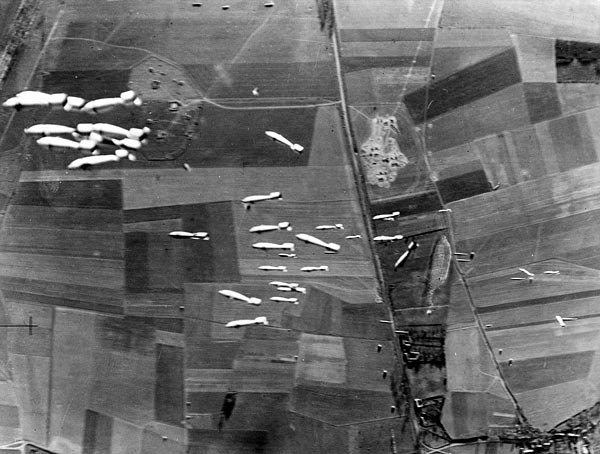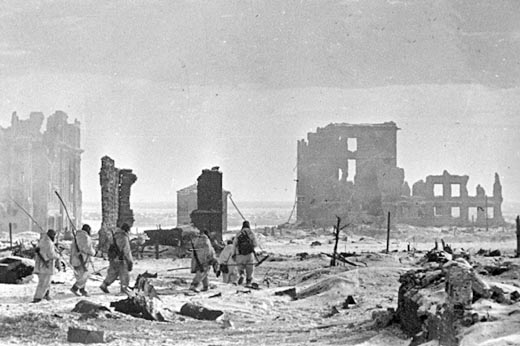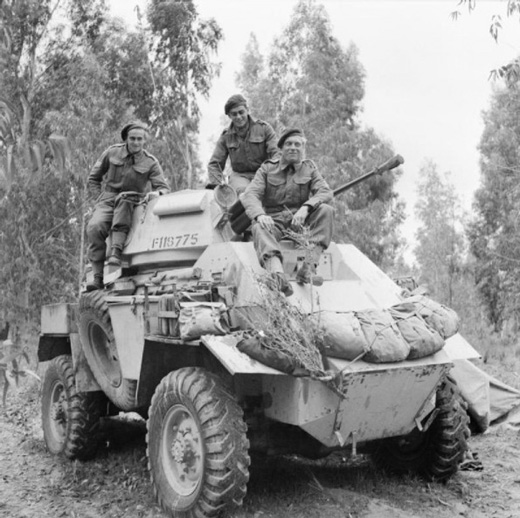Air Operations, Bismarcks
- 43rd Heavy Bomb Group B-17s attack airfields in the Rabaul area.
- 90th Heavy Bomb Group B-24s attack the Gasmata airfield on New Britain and shipping off New Britain.
Air Operations, CBI
CHINAIn their first mission since mid-January, 23rd Fighter Group P-40s attack antiaircraft emplacements and other targets at Kengtung.
[Air Operations, Europe
BOMBER COMMANDDaylight Ops:
- 36 Venturas bomb railway targets at Abbeville and Bruges without a loss.
Bombing at Abbeville |
 |
- Cologne is attacked by 161 aircraft including 116 Lancasters, 35 Halifaxes, 8 Stirlings and 2 Mosquitos.
- This is another experimental raid using 4-engine bombers and various forms of Pathfinder techniques. Markers are dropped by both the Oboe Mosquitos and the H2S heavy marker aircraft. The results are disappointing as there is no clear concentration of the markers resulting in the bombing being widely scattered. An unfortunate incident in this raid is the loss of a Stirling equipped with the new H2S device. The plane crashes in Holland and the set is recovered, damaged but able to be reassembled by German engineers at Telefunken. This would lead to the development of 'Naxos', a device that would enable German nightfighters to home in on bombers using H2S.
- 3 Lancasters, 1 Halifax and 1 Stirling are lost.
- 13 Halifaxes from No. 6 Group are sent to lay mines in the Kattegat, but run in to bad weather and only 5 aircraft drop their mines. There is also 1 OTU sortie.
- There are no losses.
Air Operations, New Guinea
- 90th Heavy Bomb Group B-24s attack Timika.
- 3d Light Bomb Group A-20s attack Japanese Army ground emplacements between Mubo and Komiatum.
Air Operations, Solomons
- XIII Bomber Command B-26s and 347th Fighter Group P-38s and P-39s attack the Munda Point airfield on New Georgia.
- XIII Bomber Command B-17s attack shipping in the Shortland Islands area.
- 347th Fighter Group P-38s and P-40s down 4 A6M Zeros and 2 A6M2-N 'Rufe' fighter-bombers over the Shortland Islands and Buin between 1615 and 1630 hours.
Air Operations, Tunisia
- Separate formations of XII Bomber Command B-25s and B-26s mount a coordinated attack against the Sfax/El Maou Airdrome.
- A-20s, escorted by P-39s and P-40s, attack an Axis munitions dump near the central battle area while other 12th Air Force fighters mount many attack in direct support of Allied ground forces.
- In a morning action near Kairouan, 33rd Fighter Group P-40 pilots down 2 FW-190s and 1 Ju-87. In several other fighter actions throughout the day, however, 33rd Fighter Group loses 6 fighters shot down or missing and 2 others written off after crash-landings.
- P-38 pilots of the 82nd Fighter Group's 96th Fighter Squadron intercept a mixed flight of Luftwaffe single- and multi-engine aircraft off Cape Bon and down 3 Bf-109s and 4 multi-engine aircraft.
Battle of the Atlantic
U-456 attacks Convoy HX-224 in the North Atlantic and torpedoes the US freighter Jeremiah Van Renssalaer (7177t) losing 10 of the 28-man Armed Guard.
[Eastern Front
The last German troops in Stalingrad, the XI Corps, surrender. Of the approximately 280,000 Germans originally surrounded in the city, 91,000 including 24 generals are prisoners and about 40,000 have been evacuated, mostly seriously wounded. The Luftwaffe has lost 500 transport planes in the fruitless supply operation and other equipment losses have been huge. The Soviets later announce that they have removed 147,000 German and 47,000 Soviet corpses from the city for reburial. The prisoners are badly treated by the Russians, and only about 5,000 ever return to Germany, the last in 1955. On the Russian side much of the credit for the success of the operation in the city must go to Gen Vasily I. Chuikov for his forceful leadership and the tactics he has developed. Zhukov's has been the dominant influence over the wider strategic plans.
Stalingrad |
 |
Kharkov, Rostov and Kursk are the next objectives that the Red Army plans to reach before the spring thaw holds up operations.
SOUTHERN SECTORThe remnants of the German XI Corps surrender at Stalingrad, bringing this titanic struggle to an end. During the Stalingrad battles the 6th Army has suffered 150,000 dead and another 90,000 taken prisoner, including 24 generals and 2,000 officers (only 6,000 will return home in the 1950s). The Luftwaffe has lost approximately 488 aircraft and 1,000 air crews during the Stalingrad airlift. Don Front's losses are 46,000 killed and missing and 123,000 wounded. To the west the Voronezh Front's 3rd Tank, 40th and 60th Armies force back German forces around Kupyansk. And the Southwestern Front unleashes its 1st Guards, 3rd Guards, 5th Tank and 6th Armies, supported by the 17th Air Army's 300 aircraft, against Army Group Don. The 3rd Guards Army crosses the Donets near Voroshilovgrad. Farther south, the German 17th Army (350,000 troops) is now isolated in the Kuban.[MORE]
[Germany, Production
Hitler orders Albert Speer, Minister of Armaments, and Heinz Guderian, Inspector General of Tank Forces, to improve the production and design of tanks.
[Guadalcanal
The 1st Battalion, 147th Infantry, succeeds in crossing the Bonegi River at its mouth by 1710 the 1st and 3rd Battalions make contact south of Tassafaronga Point. The river crossing has cost the 147th Infantry 2 men killed and 67 wounded. It is estimated that about 700-800 Japanese troops had occupied the positions east and west of the Bonegi. The Japanese have executed an orderly withdrawal but are forced to leave some equipment behind. Col Alexander George's force, the 2nd Battalion, 132nd Infantry, Americal Div, begins an advance northward along the coast. The main body moves along the beach, while G Company and 20 native scouts cover the high ground on the right flank. The coast between Verahue and Titi is passable for vehicles and trucks begin bringing up some of the supplies. By 1415 the main body has marched 3-1/2 miles to Titi.
A report comes in of 20 Japanese destroyers steaming down The Slot. Is it another attempt at reinforcement? These ships are actually the first evacuation ships. At 1700 the Cactus Air Force sends 24 bombers and 17 fighters to stop them. Yamamoto had given orders for force to be well-protected from the air. When the American planes come in for their attac they are jumped by 30 Zeros. One bomb hits the destroyer Makinami but she does not sink. The Zeros drive off the American planes before they can do more damage. The evacuation force continue on to Guadalcanal.
3 of the old 4-stack destroyers which have been converted into minelayers drop 300 mines off Cape Esperance. The Japanese force is headed for the mine field. Meanwhile PT boats launch an attack, but the Japanese ships defended themselves well. A concentrated effort by the Japanese ships sinks PT-111. Another boat, PT-48, takes so many hits the captain beaches her on Savo. PT-115 is also beached after an abortive attack. PT-37 is hit by shell that blows up the gas tank; there is only 1 survivor. PT-47 escapes into a squall near Savo. The PT boats are not only troubled by the destroyers, but by the air cover from Japanese fighers and bombers. PT-124 makes its attack and flees to safety, but the boat just following her, PT-123, is hit by a Japanese plane and is blown out of water. As the Japanese ships approach the shore, the destroyer Makigumo hits a mine which does serious damage. She is taken under tow by the Yugumo, but has to be abandoned later and is scuttled. By midnight the ships begin unloading.
[Mediterranean
The British submarine Turbulent sinks an Italian tanker(?German tanker Utilitas) carrying 5,000 tons of fuel near Palermo and prevents important fuel supplies reaching the Italian naval squadron based on Sicily.
[North Africa
TUNISIAIn the British 1st Army's US II Corps area, 1st Armored Div headquarters opens at Sbeïtla. Combat Command D drives to a ridge east of Sened, where it digs in and repels a counterattack.
First Vehicle into Tripoli |
 |
Pacific
The Japanese destroyer Makigumo is damaged by a mine laid by US minelayers Tracy (DM-19), Montgomery (DM-17) and Preble (DM-20) off Cape Esperance the previous night. She is scuttled by the destroyer Yugumo.
[